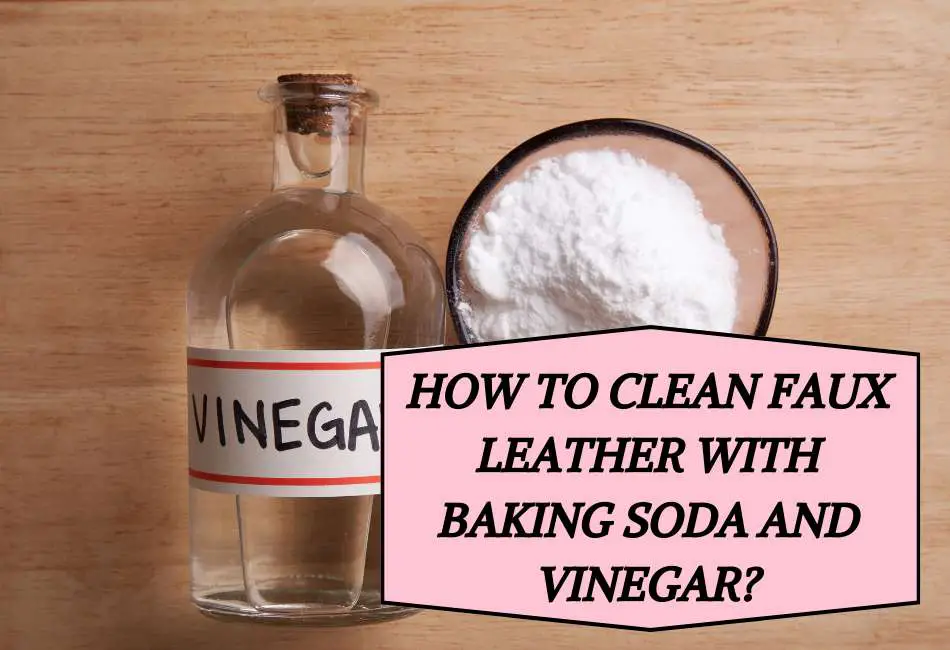Faux leather, with its durability, cost-effectiveness, and similarity to genuine leather, has gained enormous popularity in today’s fashion and interior design scene.
However, faux leather items require appropriate care and maintenance to keep them in tip-top condition like any other material. You’re in the right place if you’ve been wondering how to clean faux leather effectively.
This guide will introduce a simple yet effective cleaning method using two common household items – baking soda and vinegar.
Not only is this method easy on the wallet, but it’s also gentle on your beloved faux leather items.
Proper cleaning is crucial to extend the lifespan of your faux leather items and keep them looking their best. So, let’s dive into the process!
The Cleaning Power of Baking Soda and Vinegar
You might wonder why baking soda and vinegar are such powerhouses for cleaning, particularly faux leather. I was just as curious as you when I started this cleaning journey.
Why Baking Soda and Vinegar are Effective Cleaners:
Baking soda, known as a mild alkali, can effectively cut through grease and dirt due to its ability to neutralize acids.
Conversely, vinegar is an acetic acid that can dissolve stubborn dirt and disinfect surfaces. The combination of both these ingredients creates a potent cleaning solution.
Chemical Reactions Between Baking Soda, Vinegar, and Faux Leather:
When baking soda and vinegar combine, they fizzle and create a powerful cleaning solution. This reaction doesn’t harm faux leather; it delicately lifts stains without affecting the material’s integrity.
I remember seeing this fizzle the first time – it was just as exciting as a science class experiment!
Tackling Stains and Dirt Without Damaging the Material:
The beauty of this combination lies in its gentleness. These natural cleaners lift off dirt and grime without the harshness of commercial cleaners, ensuring your faux leather items remain undamaged.
I’ve seen this firsthand with my faux leather jacket, which miraculously looked new after being treated with this mixture!
Most Common Stains Removed
We’ve all been there – spilling wine on our favorite faux leather couch or accidentally marking it with a pen.
Here’s my take on some of the most common stains you might encounter and how baking soda and vinegar can come to your rescue.
- Wine Stains:
A wine spill can be a nightmare, but don’t fret! I once spilled red wine on my faux leather ottoman. The stain was gone after a quick dab with a cloth soaked in baking soda and vinegar solution!
- Ink Stains:
Ink stains are stubborn, but not for our trusty cleaning duo. I had a nasty pen leak on my faux leather bag once. The baking soda and vinegar solution lifted the ink right off, leaving it spotless.
- Grease Stains:
Grease can leave unsightly patches on faux leather, but worry not – baking soda and vinegar can handle this!
After a greasy pizza box left a mark on my faux leather couch, this solution came to the rescue, leaving no trace of the stain.
- Dirt Stains:
Faux leather can attract dirt over time, but regular cleaning with baking soda and vinegar can keep it looking pristine.
I make it a habit to give my faux leather items a once-over with this solution, and they always come out looking great!
1. Gathering Supplies
Before jumping into the cleaning process, let’s gather all the needed materials.
Your arsenal should include baking soda, white vinegar, a small bowl, a soft cloth, and a soft-bristle brush.
I always like to have these items at arm’s reach to attack the stain immediately!
2. Preparing the Mixture
The secret to the cleaning power is the baking soda and vinegar mixture. This is pretty straightforward – all you need to do is mix equal parts of baking soda and vinegar until it forms a paste. I’ve found that a 1:1 ratio works perfectly for most stains on my faux leather items.
3. Testing on a Small Area
To ensure it won’t discolor or damage your faux leather, it’s important to test the mixture on an inconspicuous area first.
I learned this the hard way when I left a slight bleach mark on my faux leather purse. Luckily, it was underneath, so it wasn’t visible!
4. Applying the Mixture
Once you’ve tested the mixture and are sure it’s safe, it’s time to apply it to the stain. Using a soft cloth, dab the mixture onto the stain.
Remember to dab, not rub, as rubbing can spread or deepen the stain. Trust me, I had to learn this hard with a stubborn ink stain!
5. Gentle Scrubbing
Sometimes, a stain might require a little gentle scrubbing. If this is the case, use a soft-bristle brush and gently scrub in a circular motion. This technique is particularly useful for handling stubborn dirt stains on my faux leather boots.
6. Wiping and Drying
Lastly, wipe off the mixture with a damp cloth once the stain has been treated. Ensure the item is thoroughly dry before using or storing it to prevent potential water damage.
I always leave my faux leather items to air dry – it’s been a game changer in preserving their appearance and durability!
Pros and Cons of Using Baking Soda and Vinegar on Faux Leather
Pros
- Effectiveness in Stain Removal
One of the main advantages of using baking soda and vinegar is its effectiveness in stain removal. I’ve seen this firsthand on numerous occasions.
Once, I accidentally splashed coffee on my faux leather jacket. To my surprise, a simple paste of baking soda and vinegar worked wonders and removed the stain completely!
- Eco-friendly and Affordable
Another benefit is that both baking soda and vinegar are eco-friendly and affordable. They’re household staples and won’t break the bank like some commercial cleaners.
Plus, it feels good knowing that I’m doing my part for the environment by using natural ingredients.
- Non-Toxic Nature Compared to Commercial Cleaners
Finally, baking soda and vinegar are non-toxic, unlike many commercial cleaners. I remember having allergic reactions to some leather cleaners in the past, but I’ve never experienced this with baking soda and vinegar. I can safely use them without worrying about harmful chemicals.
Cons
- Potential for Discoloration on Certain Types of Faux Leather
On the downside, baking soda and vinegar may cause discoloration on certain types of faux leather. I learned this lesson when I tried to clean an old faux leather sofa with the mixture.
The area I cleaned became slightly lighter than the rest. Always remember to do a small patch test first!
- Need for Proper Ventilation Due to Vinegar Smell
Vinegar has a strong smell that not everyone finds pleasant. It’s important to make sure you have proper ventilation when using it.
Once, I cleaned a large faux leather area rug in a room without opening the windows – the smell was overwhelming!
- Limited Effectiveness on Very Stubborn Stains
Lastly, while baking soda and vinegar can handle most stains, they may not be as effective on very stubborn stains.
I once tried to remove a red wine stain on my faux leather ottoman with the mixture, but it only faded the stain instead of completely removing it. For these stubborn cases, you might need to consider using a specialized cleaner.
Tips for Maintaining Faux Leather After Cleaning
Conditioning the Material
One of the key aspects of maintaining the quality of your faux leather items after cleaning is conditioning.
Faux leather, like real leather, can lose its flexibility and moisture after a thorough cleaning. This, in effect, could lead to cracking or peeling.
I remember one time when I spent a whole afternoon cleaning my beloved faux leather jacket only to see it starting to peel a week later.
I then learned about the importance of conditioning, which not only restores its moisture but also brings back its glossy appearance.
Now, every time I clean my faux leather items, I always finish by applying a good quality faux leather conditioner.
Regular Cleaning Schedule
Another useful tip is maintaining a regular cleaning schedule. It’s easy to neglect this, but I’ve found that routine cleaning helps prevent the build-up of dirt and stains, making the cleaning process easier over time.
Let me share a personal mistake I made – I once left a coffee spill on my faux leather purse for a week, hoping it would just fade away. It didn’t.
The stain set in and became a stubborn mark that was hard to remove. Ever since, I’ve made it a habit to clean my faux leather items immediately and scheduled a thorough cleaning every month or so just to keep them in pristine condition.
Avoiding Harsh Chemicals
Finally, while it’s important to keep your faux leather items clean, it’s equally important to avoid using harsh chemicals.
Many cleaning products on the market can cause damage to faux leather, leading to discoloration or even worse, a breakdown of the material. I once used a commercial cleaner on my faux leather car seats, thinking it would do a better job than my homemade solution.
To my dismay, it left patches of discoloration that were impossible to fix. I’ve learned my lesson and now I only use gentle, non-toxic cleaning solutions on my cherished faux leather items.
Conclusion
To conclude, my journey with faux leather care taught me many valuable lessons. One of the most surprising was the efficacy of simple household ingredients in maintaining these items.
Baking soda and vinegar turned out to be absolute game changers in my cleaning routine. Apart from being cost-effective, these natural cleaning agents are gentle on the faux leather and contribute greatly to preserving its appeal.
Let me share a quick success story. The first time I tried cleaning my faux leather jacket with a paste of baking soda and water, I wasn’t expecting much.
To my astonishment, not only did it wipe away the grime, but it also restored the jacket’s original shine! Vinegar, too, helped me salvage a faux leather sofa that had stubborn stains. I was amazed at how the vinegar solution lifted the stains without damaging the material underneath.
The key takeaway here is that faux leather, like any other material, requires proper maintenance to ensure longevity.
The regular cleaning schedule I’ve adopted, the conscious decision to avoid harsh chemicals, and my newfound love for baking soda and vinegar are all part of a holistic approach to faux leather care.
But remember, everyone’s experience with faux leather is unique. What works for one person may not work for another. I encourage you, my fellow faux leather enthusiasts, to share your own experiences and tips.
Let’s learn from each other and foster a community of faux leather lovers who know how to keep their items looking brand new for years to come!

